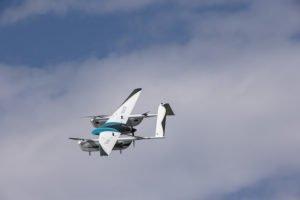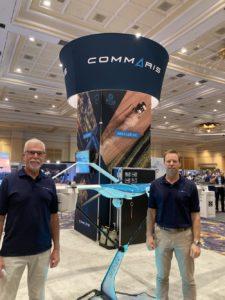

Flying car company Terrafugia launched a new brand and a new drone at Commercial UAV in Las Vegas: the Commaris SEEKER.
The CommarisTM SEEKERTM is an electric, fixed-wing/VTOL hybrid aircraft designed for autonomous commercial aerial applications.
“This UAV is designed to perform a wide variety of commercial inspection operations in applications such as power, gas, oil, mapping, agriculture, and security,” said Kevin Colburn, President of Terrafugia and Commaris. “Our team of experienced aviation professionals has created an extremely capable, commercial-grade UAV that, in many situations, will deliver results that typical rotary-wing UAVs or helicopters cannot come close to providing.”
The Commaris SEEKER offers more than three hours of flight time without a battery change, supports multiple payload configurations, and travels at a top speed of over 60 mph. It can carry a payload of up to 10 pounds; and its modular design can be assembled or disassembled in the field in under three minutes.
And, with all electric motors with a noise signature of only 40 decibels on the ground and near-silence at 500 feet AGL, the Commaris SEEKER is very, very quiet.
DRONELIFE spoke with Commaris Manager of Business Development Fred Bedard on the floor of Commercial UAV Expo in Las Vegas this week, where the SEEKER was on display.


“This is a long haul vehicle,” Bedard said. “This can stay aloft for more than 3 hours, which makes it perfect for power line inspection, pipeline inspection, agriculture – anything that requires that you fly in one direction for a long distance. You can cover about 170 miles in that timeframe.”
“Rotor wings are great at hovering, great at inspection up close – but their downfall is that 45 minute flight time,” Bedard points out. “Your personnel involvement is costly.”
A better comparison might be to a helicopter, which could cover a comparable distance. Bedard says that the Commaris SEEKER offers major advantages over helicopter operations, especially in an urban setting – or for an application like security that requires silence.
“When you have utilities that need to be monitored in an urban setting, helicopters do the job,” Bedard said. “But they’re loud: and they can’t get very close because of safety.”
“This will do everything a helicopter will do in an inspection mode – we carry the same sensors, we can fly just as long. But we’re much less expensive, we’re much less noisy, and our carbon footprint is very very low. ”
From the Commaris press release:
The SEEKER’s large payload-carrying capability will be customizable with a variety of modular options, such as a 30x optical zoom EO/IR camera for inspection, a 120-megapixel high-resolution camera for terrain mapping and 3D modeling, a six-band multispectral camera designed for precision agriculture analysis, a LiDAR system, a laser methane sensor, or a corona discharge sensor, most of which will feature the ability to stream data to the operator in near-real time.


Miriam McNabb is the Editor-in-Chief of DRONELIFE and CEO of JobForDrones, a professional drone services marketplace, and a fascinated observer of the emerging drone industry and the regulatory environment for drones. Miriam has penned over 3,000 articles focused on the commercial drone space and is an international speaker and recognized figure in the industry. Miriam has a degree from the University of Chicago and over 20 years of experience in high tech sales and marketing for new technologies.
For drone industry consulting or writing, Email Miriam.
TWITTER:@spaldingbarker
Subscribe to DroneLife here.

